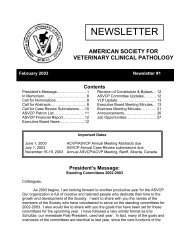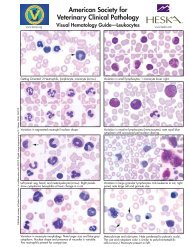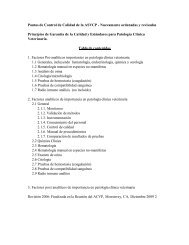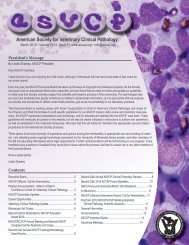Lymph Node Cytology - American Society for Veterinary Clinical ...
Lymph Node Cytology - American Society for Veterinary Clinical ...
Lymph Node Cytology - American Society for Veterinary Clinical ...
Create successful ePaper yourself
Turn your PDF publications into a flip-book with our unique Google optimized e-Paper software.
Indications <strong>for</strong> <strong>Lymph</strong> <strong>Node</strong>Aspiration• <strong>Lymph</strong>adenomegaly**• Detection of metastatic disease**• Classification of lymphoma
Indications <strong>for</strong> <strong>Lymph</strong> <strong>Node</strong>Aspiration• <strong>Lymph</strong>adenomegaly• Enlargement of one or more lymph nodes• If multiple LNs affected, sample > 1• Submandibular LNs tend to be reactive
Indications <strong>for</strong> <strong>Lymph</strong> <strong>Node</strong>Aspiration• Detection of metastatic disease• Even normal sized LNs can contain evidenceof metastatic disease
Indications <strong>for</strong> <strong>Lymph</strong> <strong>Node</strong>Aspiration• Classification of <strong>Lymph</strong>oma• Immunocytochemistry• Flow cytometry• PCR <strong>for</strong> antigen receptor rearrangement(PARR)• Often done via HISTOPATHOLOGY andIHC
Sample Acquisition• 22-gauge needle, 6 or 12 ml syringe• Aspiration vs Non-aspiration technique
Sample preparation• Slide preparation• **Slide-over-slide smears (“squash prep”)**• Blood smear technique• Be gentle, lymphocytes are fragile cells!• Quickly dry• Stain• Generally Romanowsky type stains• e.g. Wright’s stain, Diff-Quik• Leave some unstained if sending topathologist
Ruptured Cells
<strong>Cytology</strong> of Normal <strong>Lymph</strong><strong>Node</strong>s
Normal <strong>Lymph</strong> <strong>Node</strong>• 85-90% small lymphocytes• Smaller than a neutrophil or 1-1.5x diameterof RBC• Scant amount of basophilic cytoplasm• Round nucleus with clumped chromatinpattern• No nucleoli
Normal <strong>Lymph</strong> <strong>Node</strong>• 10-15% medium lymphocytes andlymphoblasts• Size of neutrophil or larger or > 2-3x diameterof RBC• Lighter, smoother chromatin pattern• Slightly more cytoplasm• +/- nucleoli
Normal <strong>Lymph</strong> <strong>Node</strong>• Low numbers of plasma cells• Moderate amount of deeply basophiliccytoplasm• Eccentric nucleus• Clumped chromatin pattern• Golgi zone(perinuclear clearing)
Normal <strong>Lymph</strong> <strong>Node</strong>• Small numbers of macrophages and raremast cells
Normal <strong>Lymph</strong> <strong>Node</strong>• Occasional neutrophils and eosinophils• Often primarily blood associated
Abnormal <strong>Lymph</strong> <strong>Node</strong>s• Reactive/hyperplastic• <strong>Lymph</strong>oma• <strong>Lymph</strong>adenitis (inflammation)• Metastatic neoplasia
Reactive/hyperplastic• Small lymphocytes still predominate• **Increased numbers of:• Plasma cells• Can see occasional Mott cells• Medium lymphoctyes andlymphoblasts
Mott Cells• Highly activated plasma cells• Cytoplasm filled with pale vacuoles• Often round to oval• “Glassy” appearance• Represent packets of immunoglobulin
Reactive/hyperplastic• May also see small increases in:• Macrophages• Neutrophils• Eosinophils• Mast cells
Atypical reactive/hyperplasticprocesses• Expanded population of intermediatelysized lymphocytes• Minimal increase in plasma cells• Can be difficult to distinguish fromlymphoma• e.g. ehrlichiosis, FeLV
<strong>Lymph</strong>oma• 50% lymphoblasts• Large cells• Smooth chromatin pattern• Often have visible nucleoli• +/- increased #’s ofmitotic figures• +/- cytophagicmacrophages
<strong>Lymph</strong>oma of Granular<strong>Lymph</strong>ocytes (LGL)• Seen most often in cats• Affected sites• GI tract• Mesenteric LNs• Liver• Spleen
<strong>Lymph</strong>oma• Diagnostic difficulties• Small cell lymphoma• GI lymphoma vs IBD• Atypical hyperplasia vs lymphoma• Histopathology (+/- IHC), PARR
<strong>Lymph</strong>adenitis• Increased numbers of neutrophils (>5%),eosinophils (>3%), or macrophages• Must take into consideration degree of bloodcontamination• Named <strong>for</strong> the predominant inflammatorycell type(s)• Reactivity/hyperplasia often present aswell
<strong>Lymph</strong>adenitis• Suppurative or (pyo)granulomatous• Must look <strong>for</strong> an etiologic agent• Metastatic neoplasia can cause this type ofinflammation
BacteriaBlastomyces sp.
Histoplasma sp.
<strong>Lymph</strong>adenitis• Eosinophilic• Hypersensitivity reactions• Parasitic• Paraneoplastic• eg Mast cell tumor
Metastatic Neoplasia• Defined by the presence of anatypical/malignant cell population• eg metastatic carcinoma• eg metastatic mast cell tumor• eg metastatic melanoma
A few other things…
Perinodal Fat
Salivary gland• Streaming pink background, windrowing ofRBCs• Glandular epithelial cells• Large amount of foamy cytoplasm• Small, round, dark nucleus
Questions/Comments










